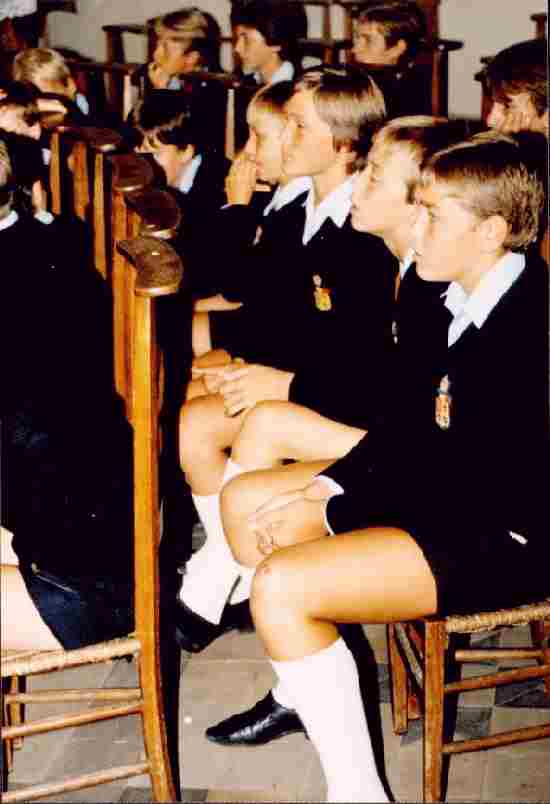
Figure 1.--Some Belgian Catholic secondary schools had uniforms consisting of blue sweaters, short pants, and white kneesocks, similar to uniforms worn in France. |

|
Most Belgian schools are state schools. The state schools are well funded and are of excellent quality. There are schools conducted in both French and Flemish depending on the language make up of the local communities. Language is a major issue in Belgium, but this in the state schools was resolved in the late-19th abd early-20th century. As is the case in much of Europe, the private sector is relatively small, in part because of the quality of the state system. The one exception is the Catholic schools. We are not sure just how large the Catholic sector is, but the Catholic schools receive state funding. Unlike the state schools, there were uniforms at some Catholic schools.
French elementary boys through the 1950s wore smocks to school, almost always black, dark blue, or grey smocks. I am not sure what Belgian schoolboys wore before the 1870s, but the school smock, as we now know it, was commonly worn in the 1870s.
Educators thought that the smock was an ideal school garment. Not only did it protect clothes, but it hid differences in clothing resulting from social class. Thus boys and girls from affluent families could not show off with expensive clothes. (Sound familiar?) I'm not sure how the style was introduced, whether there was a national policy or if local schools had any disgression. Also I am not sure to what extent the Government spelled out the style of the smocks to be worn. It does look like most of the early smocks were black or dark blue and buttoned at the back. Available images confirm that Belgian and French boys were wearing berets and smocks well before World War I--although I have no 19th Century images. The smock was generally worn with short pants and often a beret. The image of a boy going off to school in a beret, smock, and book satchel on his back is a nostalgic one for many French people. Schools smocks were still commonly worn in the 1940s because many World War II images exists of Belgian boys in smocks. I believe they were also commonly worn in the 1950s. A French contributor to this site tells me that he wore smocks as an elementary schoolboy during the late 1950s and early 60s, but did not wear a betet. Smocks began to disappear in the late 1960s, especilly after the Paris student riots of 1968. Of course it was not the elementary children rioting, but actions of the older children soon filtered down to the younger children.
I have less information about what secondary school children wore to school. Boys began secondary school at fairly young ages, about 11. Thus it is possible that some of the younger boys wore smocks in there first year of secondary school. I do not know if secondary schools had any requirement on wearing smocks or other clothing styles. I do not believe that state secondary schools required uniforms.
The Belgian Catholic schools are not really private schools in the Anglo-American sense of being entirely apartfrom the state-controlled system. they are very largely paid for by the State though there may be some small feescharged to the parents. Most of the curriculum and what now is pretty much controlled by the State like all theother schools. It's just that they have a strong religious dimension (with priests often providing thepastoral/counselling side of school life, which would be unthinkable in the ordinary state schools). The Catholic schools also had muchstricter discipline standards. In the past, te Catholic schools also required uniforms while the state schools did not, other than smocks in elementary schools. Currently the Catholic schools have generally relacced uniform standards, especially reqquiring short pants. Both Belgium and France are of course are 98 percent nominally Roman Catholic, but the question of control of education by the Church has been a major political issue in the past and was largely resolved in the 1950s and 1960s by the present compromise under which the church schools are largely funded by government. There is a partial parallel with the so-called "voluntary aided" sector in the United Kingdom, like the grammar schools many academically capable British boys once attended. Some of these schools still exist, but the "11+ exams" to select the most capable students. These schools are now entirely funded by the local education authority but retainiedng some degree of autonomyover its internal affairs (but in that case an ancient Anglican foundation).
I have little information on uniforms instituted at catholic elementary schools. Apparently there were no elementary school uniforms as in British schools, but many Catloic schools required the students to wear smocks.
Many Cattholic secondary schools also did not require uniforms. Several Catholic
secondary schools during the1950s-70s had uniforms of sweaters, short pants, and white knee socks. The shorts and white knee socks, however, became less common in the 1980s. Although several schools retained them for the choristers.
I have no infornation on private schools. Most French private schools were Cathloic schools. The extent of secular private education in Belgium is unavailable. In France and Belgium I have never heard of any "private" schools that aren't Catholic schools, except here in Brussels there are one or two "international" schools for kids of expatriats etc. which are outside the Belgian system.
Navigate the Boys' Historical Clothing Belgian pages
[Return to the Main Belgian school uniform page]
[Return to the Main Belgian page]
[Belgian royalty]
[Belgian youth groups]
[French school smocks]
[Belgian choirs]
[Belgian families]
[Belgian sailor suits]
Navigate the Boys' Historical Clothing smock pages
Related Chronolgy Pages in the Boys' Historical Web Site
[Main Chronology Page]
[The 1880s]
[The 1930s]
[The 1940s]
[The 1950s]
[The 1960s]
[The 1970s]
[The 1980s]
Created: 8:47 PM 6/6/2011
Last updated: 8:47 PM 6/6/2011
